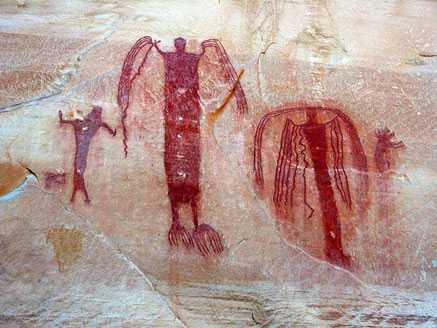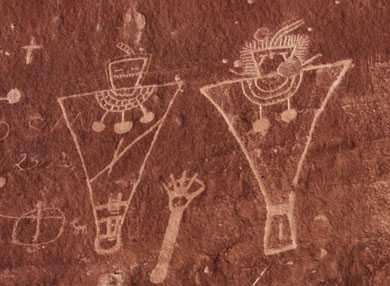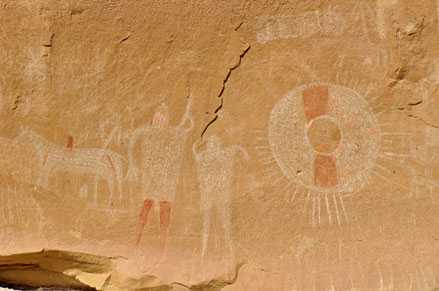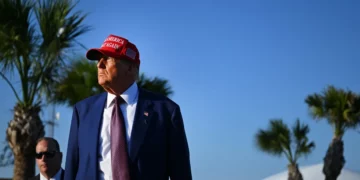The petroglyphs of Sego Canyon in Utah were painted and carved by Native Americans over a period of around 8,000 years. Those strange alien forms are still on exhibit, provocative, mysterious, and enduring memories of the individuals who once resided here. These carvings have more than 80 towering and eerie life-size figures without arms or legs or with hollowed-out or missing eyes.
Three different tribes who resided in the region — the Utes, Fremont, and Archaic peoples — created the rock art that can be seen on Sego Canyon’s walls over the course of centuries. Many people who seek more contentious theories claim that the highly odd petroglyphs seen in this place are representations of extraterrestrials that our ancestors saw. However, many prominent scientists believe that these strange, almost ghostly figures carved into the canyon walls were created by shamans or other spiritual leaders while they were experiencing an altered state of consciousness, maybe brought on by the use of natural hallucinogens.
Sego Canyon’s rock art can be classified into a variety of individual styles and historical eras. The Archaic period, which lasted from 6,000 BC to 2,000 BC, produced the oldest works of art. Archaic people are credited for creating some of the most amazing examples of rock art in the Southwest. They were nomads who foraged for wild vegetation and gathered and prepared large and small game animals. Instead of constructing permanent homes, they lived in open-air caves and little brush shelters. (Source)
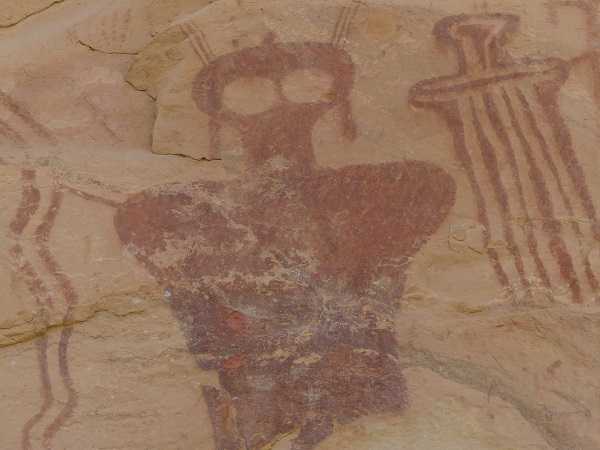
It is unknown what Native Americans were thinking when they created anthropomorphic (humanlike) creatures that were larger than life and lacked eyes, limbs, and legs in their rock art. Other portrayed individuals feature legless torsos, antennae, earrings, bug eyes, and snakes in their hands.
Some of the petroglyphs were made by the Fremont Indians, who lived in the Four Corners region from around A.D. 600 to A.D. 1250 and were contemporaneous with the Anasazi Culture. Fremont Indians frequently resided in harsh environments, but they were skilled at adjusting to their surroundings. Because of their tight ties to nature and its alterations, they had to be extremely adaptable and flexible in order to quickly shift their way of life.
Fremont petroglyphs and pictographs depict animal-like characters including deer, dogs, bighorn sheep, birds, snakes, and reptiles, as well as trapezoidal figures with limbs, legs, and fingers that are adorned with headdresses and necklaces. Additionally, the Fremont Indians created intriguing little clay miniatures of individuals that were adorned with necklaces, ear bobs, pendants, clothing, and hair. Although the function of these figures is still a mystery, it has been claimed that the Fremont people may have used them in fertility or religious rites.
The “Buckhorn Wash Angels” or “rain angels,” another strange collection of photographs, feature a variety of figures that appear to have wings or power emanating from them, however, the actual meaning is ambiguous.
The Ute people lived in Sego Canyon from 1300 AD to 1880 AD, and they carved in their own distinctive style on the cliff faces. The Utes lived in large numbers in today’s eastern Utah, western Colorado, and sections of New Mexico and Wyoming before the arrival of the Mexican settlers. The Utes were never a single entity in historical periods. On the contrary, they were made up of various nomadic tribes that kept tight ties to other nearby groups. The horse and rider images help date and identify the historic Ute rock art. The Spanish brought horses to North America in the sixteenth century.
Spiritual visions or extraterrestrials?
The bizarre figures of the Barrier Canyon-style rock art may be extraterrestrial visitors to Earth, according to ancient astronaut theorists. They cite the figurines’ big, hollow-looking eyes and triangular-shaped skulls as proof that they were not humans.
Moreover, Polly Schaafsma, an American archaeologist best known for her publications on Native American rock art asserted that these are the fine examples of shamanistic art connected to rituals practiced by the Archaic people. The “spirit figures” are usually depicted holding snake forms, and their torsos occasionally feature water/life-giving symbolism, Schaafsma noted. These related motifs are thought to be proof that a shamanic tradition was present among these Western Archaic people, at least for a brief period of time. What explains the peculiar characteristics, including the weird eyes, legless bodies, and what appear to be wings? (Source)
Schaafsma suggested that shamanistic practitioners had the capacity to enter the celestial worlds and the underworld in order to interact with “purveyors of power” with the help of various spirits. The shamanic trance experience, which is frequently induced by the use of hallucinogens, is characterized by hallucinations and visionary visions.
“With the aid of spirit helpers, tutelary deities, and divine or semi-divine beings, these otherworldly voyagers contact ancestral and supernatural powers in the interests of curing, fertility, divining, successful hunting, battle exploits, and weather control,” she wrote in a paper on the symbology of the Barrier Canyon rock art.
Nobody is fully certain of the images’ meanings or the motivations behind their creation. The god-like, towering, and fantastical images carved into Sego Canyon’s cliffs are still a mystery, and it is possible that their actual significance will never be revealed. The Antiquities Act of 1906 and the Archaeological Resources Protection Act both provide for severe penalties for vandalism at this historic site, which is listed on the National Register of Historic Places.


